The Best Chinese Five-Spice Substitute (+ the Worst)
Chinese five-spice powder is a ground spice blend. It has warm, spicy notes of cinnamon and a liquorice-like taste from star anise and fennel seeds. Try this delicious homemade Chinese five-spice recipe or any of the easy substitutes.
Chinese five-spice is a popular blend of spices used in most branches of Chinese cuisine. While there are many variants, most spice mixes have the warm flavour of cinnamon, with a hint of liquorice from star anise and fennel.
It is delicious, versatile and worth keeping in your spice rack.
Nowadays, most grocery stores will have five-spice in the spice section or Asian section. But if you can’t track it down, keep reading for the best Chinese five-spice substitutes or how to make your own.
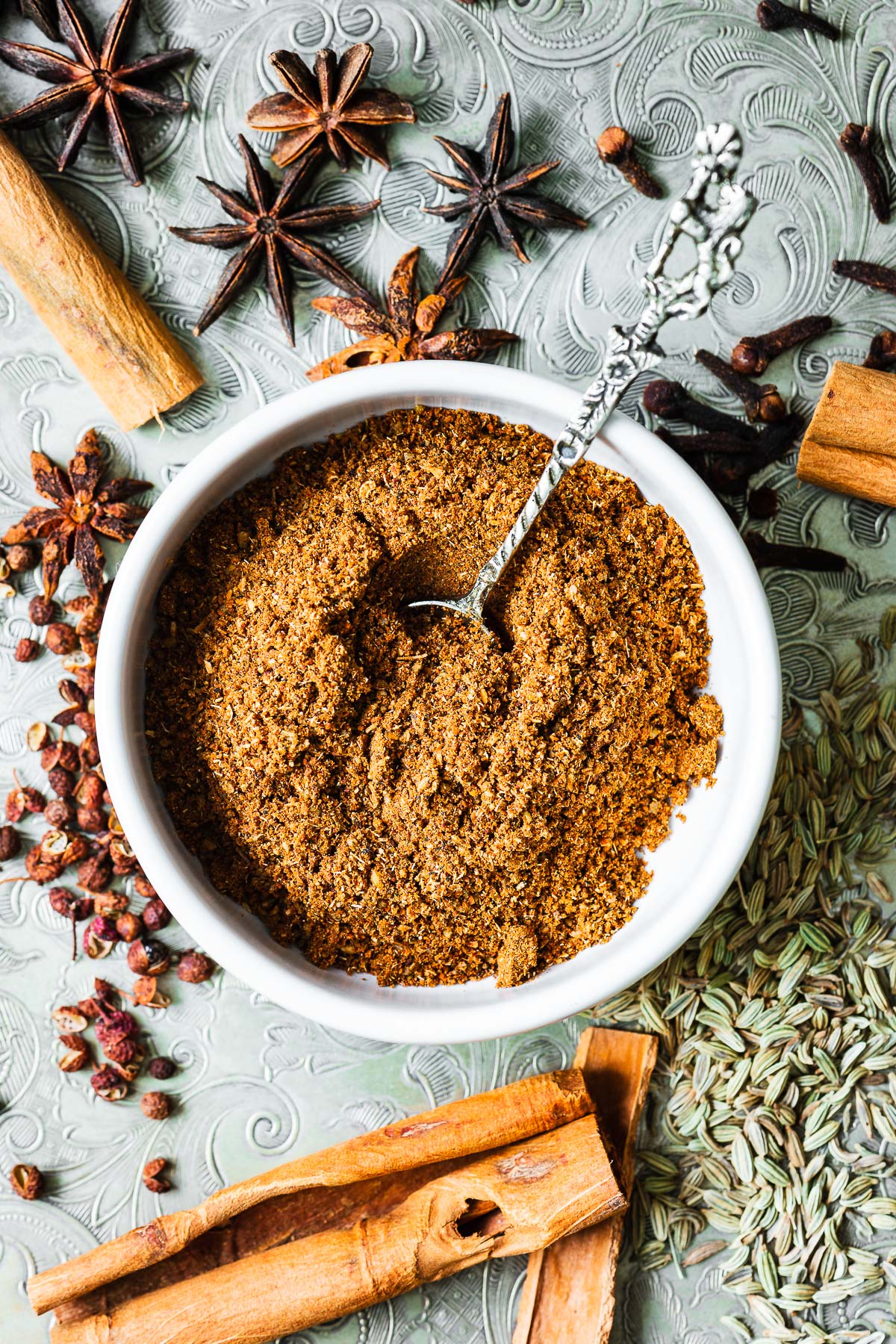
In this post, we explore
- authentic Chinese five-spice ingredients,
- how to make Chinese five-spice at home,
- the best Chinese five-spice substitutes, and
- what NOT to use as a substitute for Chinese five-spice.
Keep reading or jump straight to the recipe card for the best Chinese five-spice substitute.
Chinese five-spice ingredients
Chinese five-spice powder is a ground spice blend of five or more different spices. The five refers to the traditional Chinese flavours (sweet, bitter, sour, salty and savoury), not the number of ingredients in the spice mix.
The most common ingredients in five-spice are:
- Chinese cinnamon (cassia),
- star anise,
- fennel seeds,
- Sichuan peppercorn, and
- cloves.
Authentic Chinese five-spice may also contain anise seeds (aniseed), ginger root (ground ginger), nutmeg, turmeric, cardamom, liquorice (licorice), Mandarin orange peel and galangal.
I also noticed ajwain seeds, black pepper and white pepper in the Chinese five-spice available in the US.
Chinese cinnamon vs Ceylon cinnamon
Chinese cinnamon sticks (also called cassia) usually consist of a single thick, hard layer of bark. And Ceylon cinnamon (considered “true cinnamon”) has multiple thin layers and is much easier to blend into a powder.
Chinese cinnamon has a bolder taste. It’s spicier and a touch more bitter in comparison to the mellow sweet taste of true cinnamon. Cassia also has a reddish hue compared to the light tan colour of cinnamon.
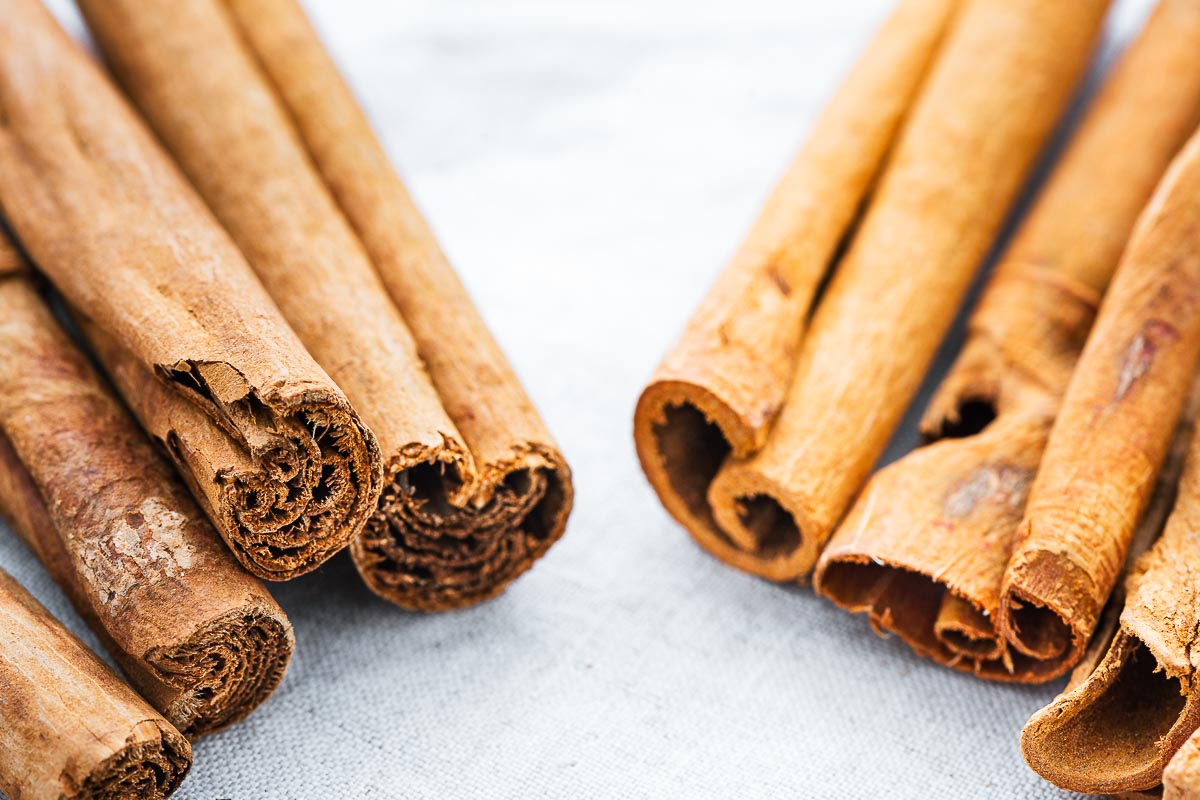
If unsure of the type, check the product label for its country of origin. Ceylon cinnamon is native to Sri Lanka (previously known as Ceylon). And 80% of true cinnamon still comes from Sri Lanka. Read more about true Ceylon cinnamon from Sri Lanka.
Chinese cinnamon grows wild in the mountains of Southern China.
Ceylon cinnamon sticks are more expensive than cassia. It is why the majority of ground cinnamon in grocery stores often contains cassia. You can buy both types as quills (cinnamon sticks or pieces of bark) or ground powder.
You can use Chinese or Ceylon cinnamon when you make five-spice at home.
What does Chinese five-spice taste like?
Chinese five spice has a warm and spicy cinnamon flavour with sweet liquorice-like tones from the star anise and fennel seeds.
Don’t be surprised if a mouth-numbing tingling sensation follows the sweet taste. The Chinese spice blend can contain Sichuan peppercorns.
The powder has a fine texture similar to ground cinnamon and a dark brown colour.
How to make Chinese five-spice
As with all spices, the fresher the ground, the better the flavour. And if you have a spice grinder, using whole spices for your Chinese five-spice substitute is super easy, not to mention utterly delicious.
But I also provide pre-ground alternatives if you don’t have the right tools.
Homemade Chinese five-spice ingredients
- Cinnamon: I use a Chinese cinnamon stick (of roughly five grams) in my five-spice blend, but you can also use a Ceylon cinnamon stick or ground cinnamon. Two teaspoons of ground cinnamon weigh the same as one stick, but freshly ground cinnamon has a stronger flavour.
- Ground substitute: Use one tablespoon of ground cinnamon to replace one stick of Chinese cinnamon.
- Star anise: These beautiful star-shaped pods have a distinctive sweet liquorice flavour. After cinnamon, star anise is the most common ingredient in the Chinese five-spice blends I reviewed.
- Ground substitute: Use one tablespoon of ground star anise or half a tablespoon of anise seed powder to replace six whole star anise pods.
- Fennel seeds: Fennel seeds also contribute to the liquorice flavour, but it is less sweet and more savoury when compared to star anise.
- Ground substitute: Replace one tablespoon of fennel seeds with one tablespoon of ground fennel powder.
- Sichuan peppercorns: Also known as Szechuan pepper, these peppercorns have a citrus-like flavour with a distinct mouth-numbing sensation caused by the hydroxy-alpha sanshool.
- Ground substitute: While Sichuan pepper is nothing like black or white pepper, you can substitute the Sichuan with a pinch of ground white pepper to add a touch of heat to your five-spice.
- Cloves: This warm spice has a slightly bitter taste. I only include a small number of cloves in this recipe, but if you find cloves too pungent, you can omit them.
- Ground substitute: Replace half a teaspoon of whole cloves with half a teaspoon of ground cloves.

Grind whole spices into a powder
Break any large pieces of cinnamon into smaller pieces of bark. Then grind the whole spices into a powder with a spice or coffee grinder. Or, simply stir together the ground spice substitutes.
You can toast your whole spices in a hot, dry pan for a few minutes before grinding them. It intensifies the flavour, but I often skip this step. The mix is pretty intense already!
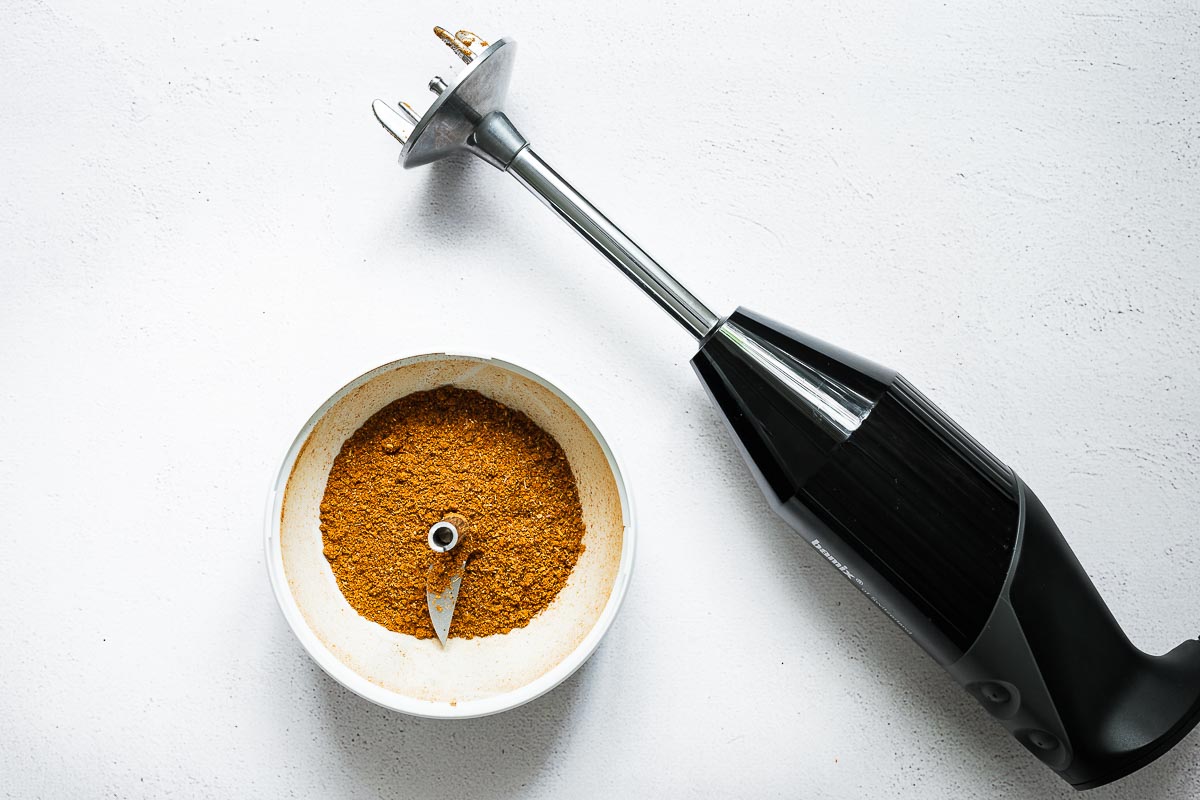
The best substitutes for Chinese five-spice
The best substitute for Chinese five-spice powder is a homemade blend of whole Chinese cinnamon sticks, star anise pods, fennel seeds, Sichuan peppercorns and cloves.
If you don’t have a spice grinder, try the ground cinnamon spice mix. It is another great substitute for five-spice.
Or you can rely on cinnamon and star anise to get you most of the way there.
1. Homemade Chinese five-spice
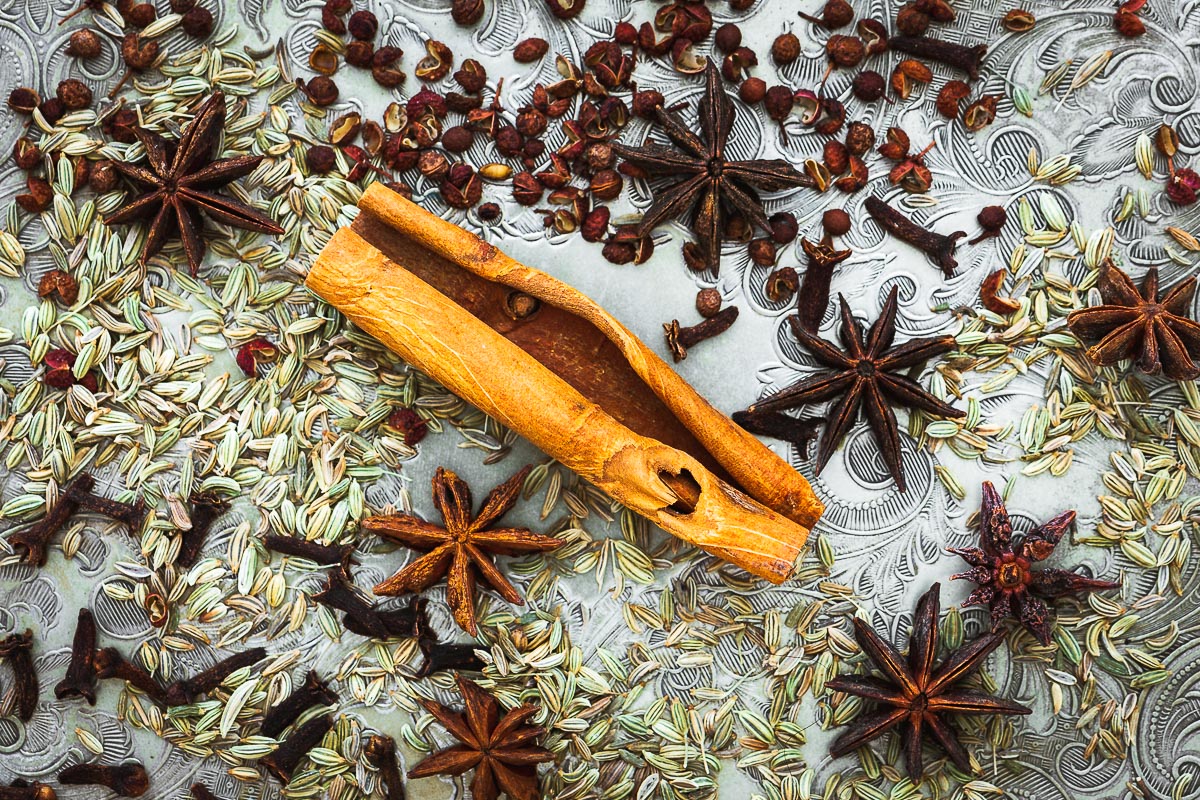
The best substitute for Chinese five-spice is this homemade version with whole spices.
With a spice or coffee grinder, grind whole Chinese cinnamon sticks, star anise pods, fennel seeds, Sichuan peppercorns and cloves into a fine powder. See the recipe card for detailed instructions.
But, while this spice mix is an excellent substitute for shop-bought five-spice, it does have two drawbacks.
- You need a spice grinder.
- It is difficult to make small amounts at a time.
If this is a problem for you, try the next pre-ground alternative for Chinese five-spice.
2. Ground cinnamon spice mixture
This ground cinnamon mix is your best option when you only need a small amount of five-spice.
Mix one teaspoon of ground cinnamon with one teaspoon of ground star anise, a teaspoon of ground fennel (also called soomph powder), a pinch of ground cloves, and a pinch of ground white pepper.
Use this ground cinnamon mix as a direct substitute for Chinese five-spice.
3. Cinnamon
Cinnamon is the only spice that occurs in all of the top ten Chinese five-spice blends on Amazon. It is an essential ingredient in Chinese five-spice. It, therefore, also makes a great substitute.
Use one tablespoon of ground cinnamon to replace a tablespoon of Chinese five-spice.
Or, add a whole cinnamon quill to soups, stews and braising liquids. Use roughly one stick of cinnamon to replace each tablespoon of five-spice. Remove the cinnamon sticks before serving your dish.
4. Star anise
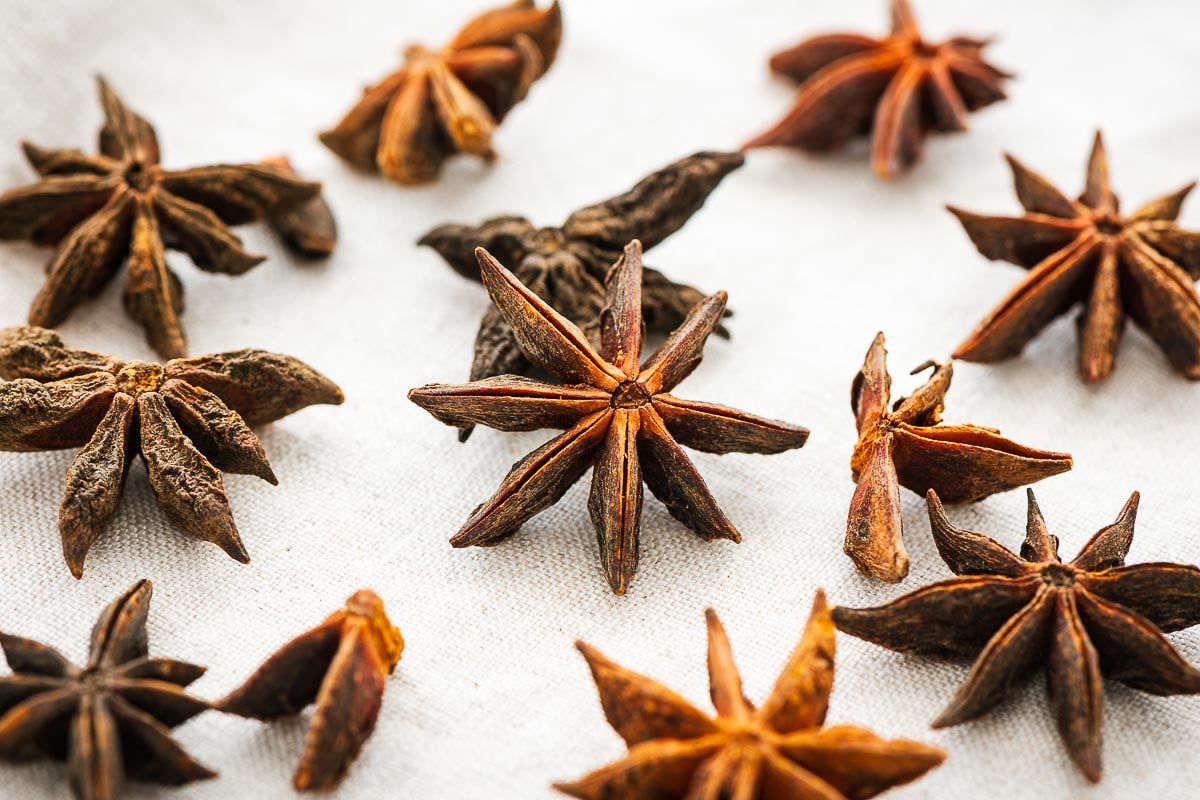
These beautiful star-shaped pods have a sweet, liquorice-like taste. Don’t confuse them with anise seed (or aniseed). Star anise is much milder.
After cinnamon, star anise is the most popular spice in the Chinese spice mix.
Star anise is available in two forms, whole pods or ground powder.
Use ground star anise as a direct substitute for Chinese five-spice.
Or, add three whole pods to soups, stews and braising liquids to replace one tablespoon of five spice. Remove the pods before serving your dish.
5. Cinnamon + star anise
Yes, I know we already looked at cinnamon and star anise individually. But this spice mix is the closest you will get to five-spice using only two spice rack staples.
This combination of spices makes an excellent Chinese five-spice alternative. You get the warm, spicy cinnamon notes and the sweet, liquorice flavour.
Combine equal parts ground cinnamon and ground star anise to use as a direct substitute for Chinese five-spice.
Or add a cinnamon quill and three whole star anise pods to your soup, stew or braising liquid. Remove the whole spices before serving your dish.
6. Allspice
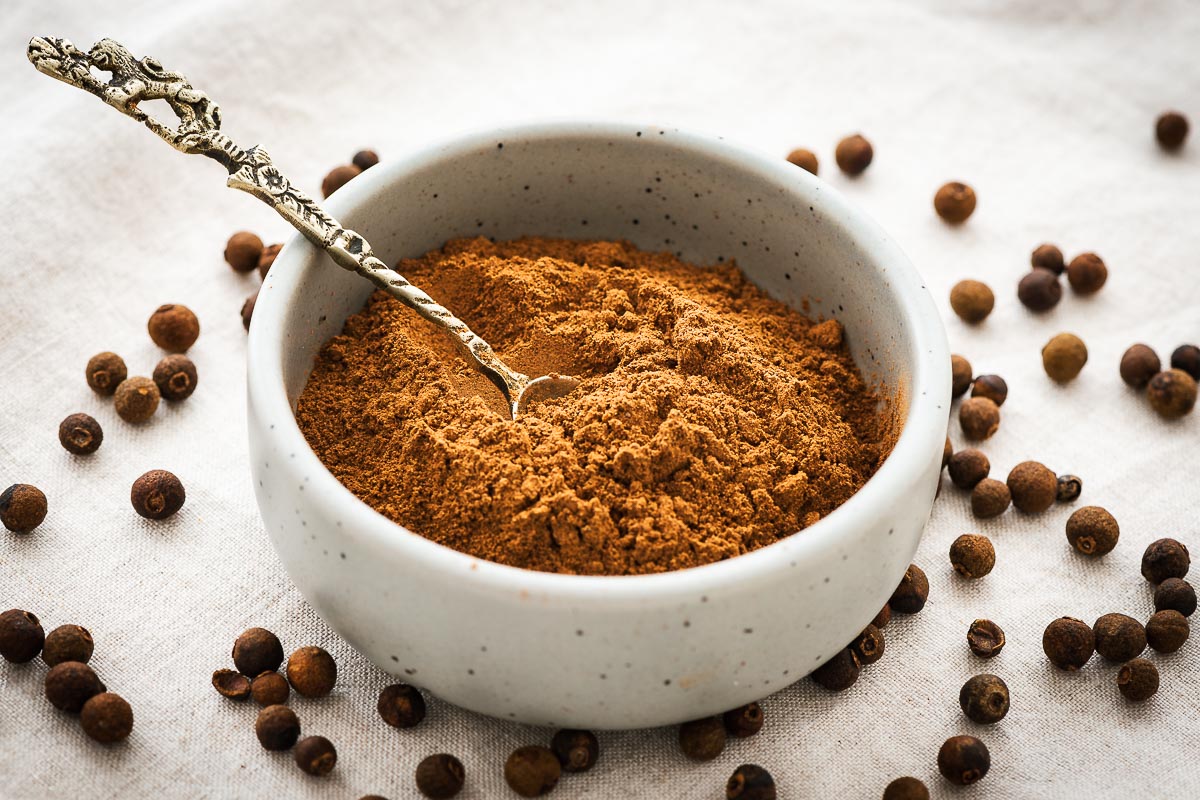
It makes sense that allspice is often mistaken for a spice blend. The flavour profile is multidimensional with notes of cinnamon, cloves, nutmeg and pepper. It is the dried berries of the pimenta dioica plant.
Allspice is the best single spice powder substitute for Chinese five-spice.
Use ground allspice as a direct substitute for five-spice.
Or add a tablespoon of dried allspice berries to pickling or braising liquids.
If you add whole allspice berries to soups and stews, it is best to tie them in a small muslin cloth bag (like a bouqet garni) or use a tea ball. It makes it easier to fish them out before serving.
7. Garam masala
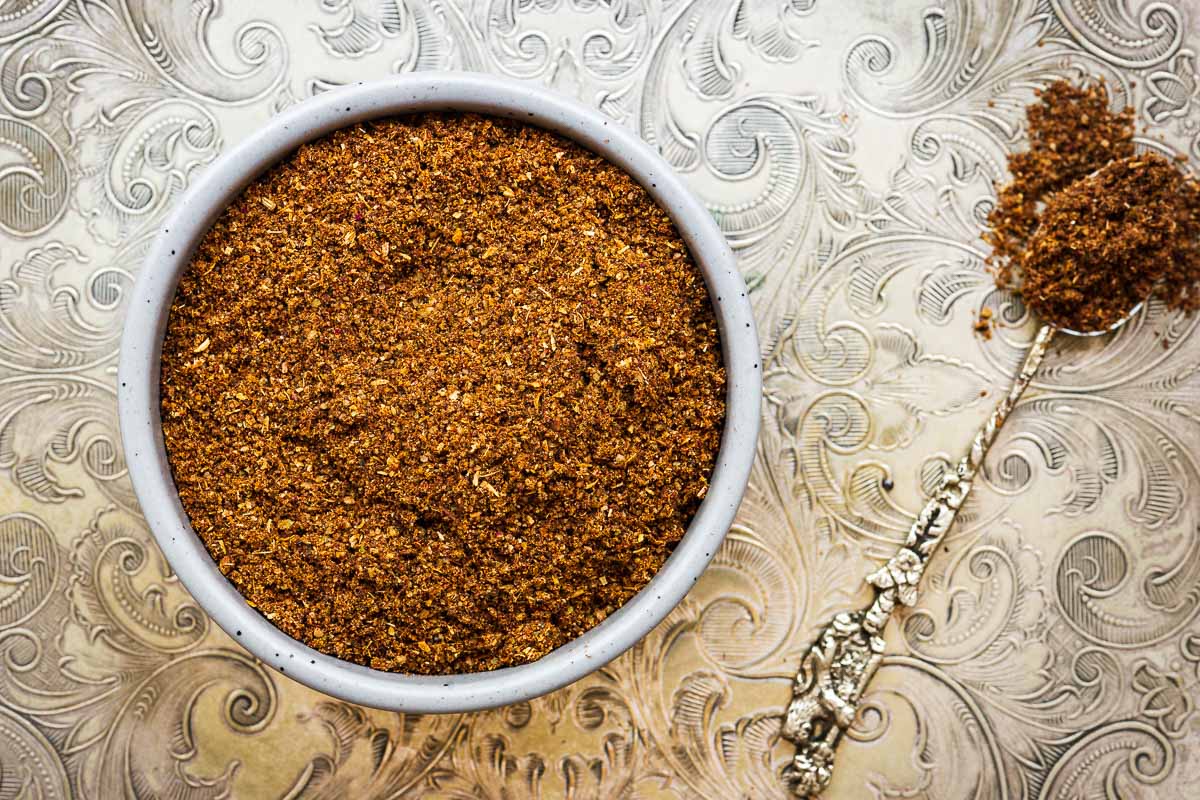
It is surprising just how many spices garam masala has in common with Chinese five-spice.
Garam masala is a blend of ground spices from India. It is common in Caribbean, Pakistani, Nepalese, Bangladeshi, Sri Lankan and Indian cuisine.
A typical Indian garam masala contains fennel, bay leaves, black and white peppercorns, cloves, cinnamon or cassia bark, mace (the outer covering of nutmeg), black and green cardamom pods, cumin, coriander seeds and red chilli powder.
While garam masala typically contains cinnamon, it is not as cinnamon-forward as Chinese five-spice. So, add an extra pinch of ground cinnamon and use garam masala as a direct substitute.
Related post: Garam masala substitutes (+ homemade garam masala recipe)
8. Lebanese seven-spice (baharat)
Bahārāt is the Arabic word for spices. And Lebanese seven-spice is sometimes referred to as baharat, even though baharat can include more than seven ingredients.
The spices in Lebanese seven-spice vary. Most blends have cinnamon, ginger, allspice, black peppercorns and cloves. The remaining two ingredients can be cardamom, coriander, cumin, nutmeg, fenugreek or mahlab.
You can use Lebanese seven-spice as a direct substitute for Chinese five-spice, but it works better with a pinch of ground anise (star anise or anise seed) or ground fennel seeds.
9. Ras el hanout
Ras el hanout means “head of the shop” in Arabic. The exact spice mix varies across shops in Tunisia, Algeria and Morocco. It is a delicious rub for meat or fish and elevates simple couscous, pasta or rice dishes.
Common ras el hanout ingredients include cardamom, cumin, clove, cinnamon, nutmeg, mace, allspice, ground ginger, chilli peppers, coriander seed, peppercorn, sweet or hot paprika, fenugreek and turmeric.
While ras el hanout has a complex flavour, it lacks the anise flavour associated with Chinese five-spice. So, as with baharat, it is a good alternative for Chinese five-spice if you add a pinch of ground anise or fennel.
If your ras el hanout is very coarse, you can grind it in a spice grinder or pestle and mortar for a finer texture.
What not to use as a Chinese five-spice substitute
Za’atar
I see za’atar recommended on quite a few lists. But I certainly would not use za’atar as a substitute for Chinese five-spice.
Za’atar is a culinary herb family (including species of thyme and oregano). It also refers to the Middle Eastern spice mix containing za’atar herbs, sesame seeds, sumac and spices.
It has a strong herb flavour from thyme and oregano, with nutty sesame and acidic berry flavours from the sumac.
None of these flavours contributes to a good Chinese five-spice alternative.
Instead, try this homemade Chinese five-spice substitute recipe or any of the alternatives suggested above.
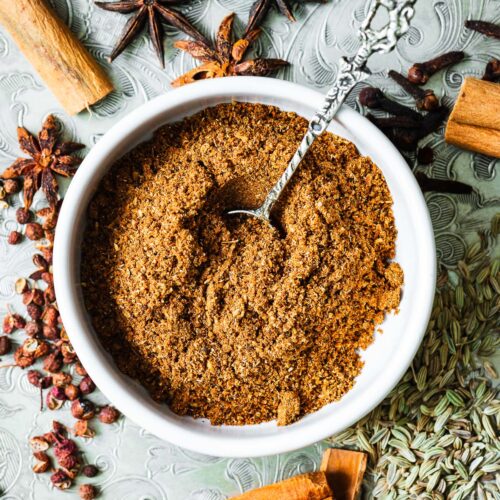
Equipment
- Spice grinder – to grind whole spices, or follow directions for ground spices.
Ingredients
- 6 whole star anise pods (5 grams), or 1 tablespoon of ground star anise
- 1 cinnamon stick (5 grams), or 1 tablespoon of ground cinnamon
- 1 tablespoon fennel seeds, or 1 tablespoon ground fennel
- 2 teaspoons Szechuan peppercorns (optional)
- ½ teaspoon whole cloves (about 8), or ½ teaspoon ground cloves
Instructions
- Break the cinnamon bark into smaller pieces. Add it to a spice grinder (or coffee grinder) along with the rest of the whole spices, and blitz into a fine powder.
- Transfer the ground spices to an airtight container (or spice jar) and use it within a few months for the best flavour.
Notes
- You can also toast your whole spices in a hot, dry pan before you grind them. It takes about three minutes.
- If using the pre-ground spices, stir them together in a small bowl.
- While the spice mix won’t go off anytime soon, they start to lose their intensity as soon as they are ground. So, for the best flavour aim to use it within three months.
Try your homemade Chinese five-spice substitute in this roasted pink oyster mushroom recipe with soy sauce and five-spice marinade.
Or try another homemade spice blend?

The spice has a delicious flavour but it discoloured the plastic lid of my spice grinder.
Do you know why this is and how I can remove the white stain it left?
I’m so happy you loved the Chinese five-spice blend, Patricia!
Regarding the white stain, I have no idea why this spice blend would cause a white stain. I’ve made it countless times in my plastic Bamix grinder (white plastic bottom and clear plastic lid) without any staining. But I’m happy to help you get to the bottom of this! So I had a look around:
1. To clean a spice grinder, most people recommend using rice. This article gives the step-by-step instructions. But I’m not sure if this will help with a stain.
2. Baking soda is excellent at removing stains or grime on clear plastic. Sprinkle a thick layer of baking soda onto the lid, then sprinkle water over to form a thick paste. Rub the paste all over the stain and let it sit. Leave for 30 to 60 minutes, then wash with normal dishwashing liquid.
You’re welcome to reach out via my contact form then I can help you solve this over email, and you can send pictures of the lid.
This Chinese Five-Spice Substitute recipe is fantastic! It’s easy to make and perfectly captures the essence of traditional five-spice. A great addition to any dish needing a flavorful boost. Thank you!
I’m so happy you liked the recipe, Heather! It really does add so much flavour!
Great spices! So warming and delicious, and even better that I made the mix myself. Thank you!
I’m happy you liked the spice mix, Harriet!